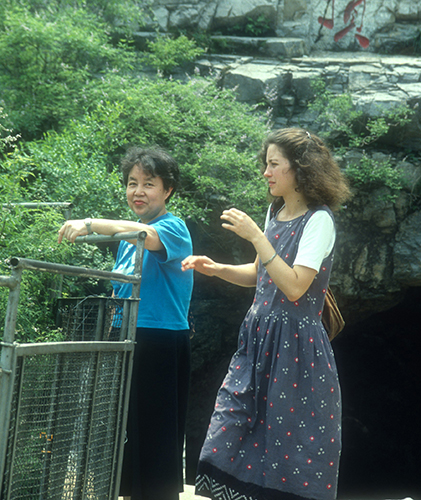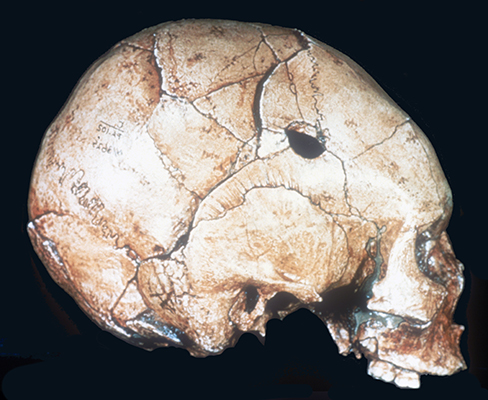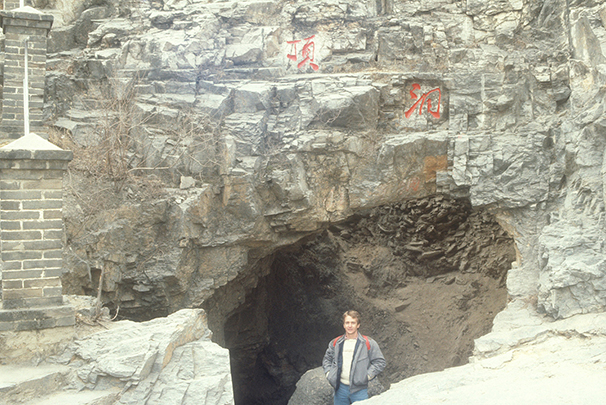![]()

Leading zooarchaeologist and palaeoanthropologist Professor Qi from the IVPP explaining the details of the Zhoukoudian site to Australian student Phoebe Newman in 1995.
![]()
The Upper Cave (Shandingdong) skeletons were excavated in 1933 and 1934, with the archaeological assemblage discussed by Pei (1935, 1939) and the human skeletal materials briefly described by Weidenreich (1939) and in more detail by Wu (1960, 1961). The fauna recovered from the lower chamber of the cave suggested to Pei that the deposits were of late Pleistocene age and this was confirmed by conventional radiocarbon dates on non- human bone (Wu and Wang 1985), as well as more recent AMS dates (Chen et al. 1989; Hedges et al. 1992; Hedges et al. 1988). Dates now extend from 10,175 ± 360 BP (ZK-136-0-4) for the upper part of the cave to 33,200 ±2000 BP (OXA-190) for the basal layers. Unfortunately, as I have discussed previously (Brown 1992), the published accounts of the excavation contain insufficient information to be certain of the stratigraphic relationship between the human remains and the dated animal bones.
Both Weidenreich (1939) and Pei (1935, 1939) argue that the human remains were part of intentional burials, with the skeletons subsequently disturbed and disarticulated by animal activity or erosion. It remains unclear whether the burials are contemporaneous with layer 4 or had been interred from a higher layer. Wu and Wang (1985) argue that the older dates from the Upper Cave are well below the areas of human occupation, which they place at around 10,000 BP, while (Chen et al. 1989; Hedges et al. 1992; Hedges et al. 1988) suggest 29-24 ka BP for the cultural layers. Li et al. (2018) report new AMS dates for the Upper Cave of 35-33 ka BP which they believe provide a guide to the age of the human burials. As the AMS dates are for non-human mammal bone, not one of the three human skeletons, they date part of the deposit and the relationship to the human burials is unknown.
![]()


![]()
Weidenreich (1939) believed that the Upper Cave skeletons provided the earliest evidence for the presence of modern humans in the East Asian region. What perplexed Weidenreich, however, was the variation between the three crania, 101, 102 and 103, and the absence of clearly defined East Asian skeletal morphology. When discussing the racial affinity of these crania 101 was considered to be a primitive Mongoloid, 102 a Melanesian and 103 an Eskimo. These conclusions, at best poorly supported, have been discussed in some detail by a number of authors, particularly in relation to the evolutionary history of East Asia (Coon 1962; Kaminga and Wright1988; Wolpoff et al. 1984; Wu 1960, 1961). Unfortunately, the original specimens, along with the Locality 1 Homo erectus materials, were lost in 1941 (Shapiro 1976) and can now only be studied through casts.One of the crania, the so called "Melanesian woman" 102 (below), was also thought to have had her head shape modified when she was a child.

Of the three crania Upper Cave 101, the "old man", has been studied in more detail primarily due to its better preservation and clearly adult status. In comparison to modern East Asians the cranial vault is extremely long and low, with a receding frontal squama and marked angulation in the occipital region. The forehead is broad and the supercilliary region well developed. The nasal bones are pinched, with a high bridge, and the nose must have been more prominent than is common amongst living East Asians. The orbits are relatively low and rectangular, which is a common feature in terminal Pleistocene and Neolithic crania from many parts of the world. The lower border of the nasal aperture is gutted, which is customary amongst East Asians, Australian Aborigines and sub-Saharan Africans. There is moderate sub-nasal prognathism and the mandible has a prominent chin, slight gonial eversion, trace of a mandibular torus and a broad ramus. Weidenreich (1939) did not record dental dimensions and the moderately worn teeth have not been described in detail. All teeth are present and the arch is well spaced, without malocclusion. Comparison of tooth wear rates with known age hunter gatherers suggest that Upper Cave 101 was probably in his late 30's when he died and not an "old man" by today's standards.
To what extent the oro-facial skeleton and cranial vault of Upper Cave 101 contains either "proto-Mongoloid" or East Asian anatomical characteristics has been the subject of some debate (Kaminga and Wright 1988; Wolpoff et al. 1984; Neves and Pucciarelli 1998). Living East Asians and Native Americans have a facial skeleton characterised by great facial height, a tall nasal aperture, high orbits, limited overall prognathism but often marked subnasal prognathism, only moderate bi-frontal breadth but a relatively broad mid-facial region. The nasal bones are generally flattened rather than pinched, the anterolateral surface of the frontal processes of the malars are rotated forwards and the inferior half of the external surface of the malars tend to be orientated upwards, rather than perpendicular. This suite of features are also found in the early Neolithic sites of Baoji (Yan et al. 1960) and Huaxian (Yan 1962) but they are not a feature of Upper Cave 101.Turner (1992) has argued that his Sinodont pattern was "probably present in the late Pleistocene north China Upper cave crania" (:145), however, it is unlikely that the majority of his dental traits can be reliably scored on the Upper Cave casts. Neves and Pucciarelli (1998) argue that not only are "Mongoloid" morphological features not present in Upper Cave 101, they are not present in South Ameican paleoindian crania either. They conclude that East Asian morphological features evolved in the Old World after the initial migration to the Americas. I think that this is supported by what is currently known from the Paleolthic and Neolithic skeletal assemblages from China (Brown 1999). People with a distinctive East Asian appearance do not appear until the Neolithic period at sites like Baoji at around 7000 years BP. Harvati (2009) completed a geometric morphometric re-assessment of the Upper Cave crania, which also confirmed the distinction from recent East Asians made by Brown (1992, 1999) and others. Not surprising as they are not modern East Asians and preserve morphological features common to Late Pleistocene modern humans throughout the Old World.

![]()
Brown, P. 1992. Recent human evolution in East Asia and Australasia. Philosophical Transactions of the Royal Society London, Series B 337:235-242.
Brown, P. 1998. The first Mongoloids: another look at Upper Cave 101, Liujiang and Minatogawa 1. Acta Anthropologica Sinica 17 (4):255-275.
Brown, P. 1999. The first modern East Asians. In K. Omoto (ed.), Interdisciplinary Perspectives on the Origins of the Japanese, pp 105-124. International Research Center for Japanese Studies, Kyoto.
Chen, T., Hedges, R. E. M. and Yuan, Z. 1989. Accelerator radiocarbon dating for the Upper Cave of Zhoukoudian. Acta Anthropologica Sinica 8:216-221.
Coon, C. S. 1962. The Origin of Races. Knopf, New York.
Harvati, K. 2009. Into Eurasia: A geometric morphometric re-assessment of the Upper Cave (Zhoukoudian) specimens. Journal of Human Evolution 57: 751-762.
Hedges, R. E. M., Housley, R. A., Bronk, C. R. and Van Klinken, G. J. 1992. Radiocarbon dates from the Oxford AMS system: Archaeometry Datelist 14. Archaeometry 34:141-159.
Hedges, R. E. M., Housley, R. A., Law, I. A., Perry, C. and Hendy, E. 1988. Radiocarbon Dates from the Oxford AMS System: Archaeometry Datelist 8. Archaeometry 30:291-305.
Kamminga, J. and Wright, R. V. S. 1988. The Upper Cave at Zhoukoudian and the origins of the Mongoloids. Journal of Human Evolution 17:739-767.
Li, F. et al., 2018. Re-dating Zhoukoudian Upper Cave, northern China and its regional significance. Journal of Human Evolution 121: 170-177
Neves, W. and Pucciarelli, H. 1998. The Zhoukoudian Upper Cave skull 101 as seen from the Americas. Journal of Human Evolution 34: 219-222.
Norton, C.J. and Gao, X. 2008. Zhoukoudian Upper Cave revisited. Current Anthropology 49 (4)
Pei, W. 1935. A preliminary report on the Late Palaeolithic Cave of Choukoutien. Bulletin of the Geological Society of China 13: 327-358.
Pei, W. 1939. On the Upper Cave Industry. Palaeontologica Sinica D9: 1-141.
Shapiro, H. L. 1976. Peking Man. George Allen and Unwin, London.
Turner, C. G. 1992. The dental bridge between Australia and Asia: following Macintosh into the East Asian hearth of humanity. Archaeology in Oceania 27:120-127.
Weidenreich, F. 1939. On the earliest representatives of modern mankind recovered on the soil of East Asia. Bulletin of the Natural History Society of Peking 13:161-174.
Wolpoff, M. H., Wu, X. and Thorne, A. G. 1984. Modern Homo sapiens origins: a general theory of hominid evolution involving the fossil evidence from east Asia. In F. H. Smith and F. Spencer (eds.), The origins of modern humans, pp. 411-484. Alan. R. Liss, New York.
Wu, X. 1960. On the racial type of Upper Cave man of Choukoutien. Gu Jizhuidongwu yu Gu Renlei 2:141-149.
Wu, X. 1961. Study of the Upper Cave Man of Choukoutien. Vertebrata PalAsiatica 3:181 211.
Wu, X. 1988. The relationship between Upper Palaeolithic human fossils of China and Japan. Acta Anthropologica Sinica 7:235-238.
Wu, X. 1990. The evolution of humankind in China. Acta Anthropologica Sinica 9:312-322.
Wu, X. 1992. The origin and dispersal of anatomically modern humans in East and Southeast Asia. In T. Akazawa, K. Aoki and T. Kimura (eds) The evolution and dispersal of modern humans in Asia, 373-378. Hokusen-sha, Tokyo.
Wu, X. and Wang, L. 1985. Chronology in Chinese Palaeoanthropology. In R. Wu and J. W. Olsen (eds.), Palaeoanthropology and Palaeolithic Archaeology in the People's Republic of China, pp. 29-68. Academic Press, London.
Wu, X. and Wu, M. 1985. Early Homo sapiens in China. In R. Wu and J. W. Olsen (eds.), Palaeoanthropology and Palaeolithic Archaeology in the People's Republic of China, pp. 91 105. Academic Press, London.
Wu, X. and Zhang, Z. 1985. Homo sapiens remains from Late Palaeolithic and Neolithic China. In R. Wu and J. W. Olsen, Palaeoanthropology and Palaeolithic Archaeology in the People's Republic of China, pp. 107-133. Academic Press, London.
Yan, Y. 1962. A study of the Neolithic human skeletons from Huaxian, Shaanxi. Acta Archaeologica Sinica 2:85-104.
Yan, Y., Liu, C. and Gu, Y. 1960. Study of the Neolithic human skeletons from the Baoji site, Shaanxi. Gu Jizhuidongwu yu Gu Renlei 2:33-43.
![]()
| Variable list | U.C. 101 | Liujiang | Minatogawa |
| glabella-opisthocranion | 206 | 191 | 181 |
| basion-nasion | 109 | 105 | 102 |
| basion-bregma | 133 | 135 | 136 |
| max. cranial breadth | 144 | 143 | 147 |
| bi-auricular breadth | 137 | 126 | 129 |
| bi-asterionic breadth | 122 | 108 | 117 |
| basion-prosthion | 107 | 104 | (105) |
| nasion-prosthion | 76 | 66 | (61) |
| nasal height | 58 | 46 | (50) |
| nasal breadth | 33 | 25 | 25 |
| palate breadth | 69 | 64 | (65) |
| mastoid height | 31 | 22 | 32 |
| orbit height | 34 | 27 | 30 |
| orbit breadth | 45 | 41 | 45 |
| bi-maxillary breadth | 104 | 98 | (105) |
| bi-frontal breadth | 108 | 106 | 111 |
| nasion-bregma chord | 116 | 102 | 105 |
| nasion-bregma subt. | 29 | 28 | 20 |
| nasion-subtense fraction | 64 | 52 | 47 |
| bregma-lambda chord | 120 | 118 | 111 |
| bregma-lambda subt. | 22 | 25 | 24 |
| bregma-subtense fraction | 52 | 65 | 61 |
| lambda-opisthion chord | 98 | 92 | (95) |
| lambda-opisthion subt. | 28 | 25 | (22) |
| lambda-subtense fraction | 33 | 37 | (32) |
![]()